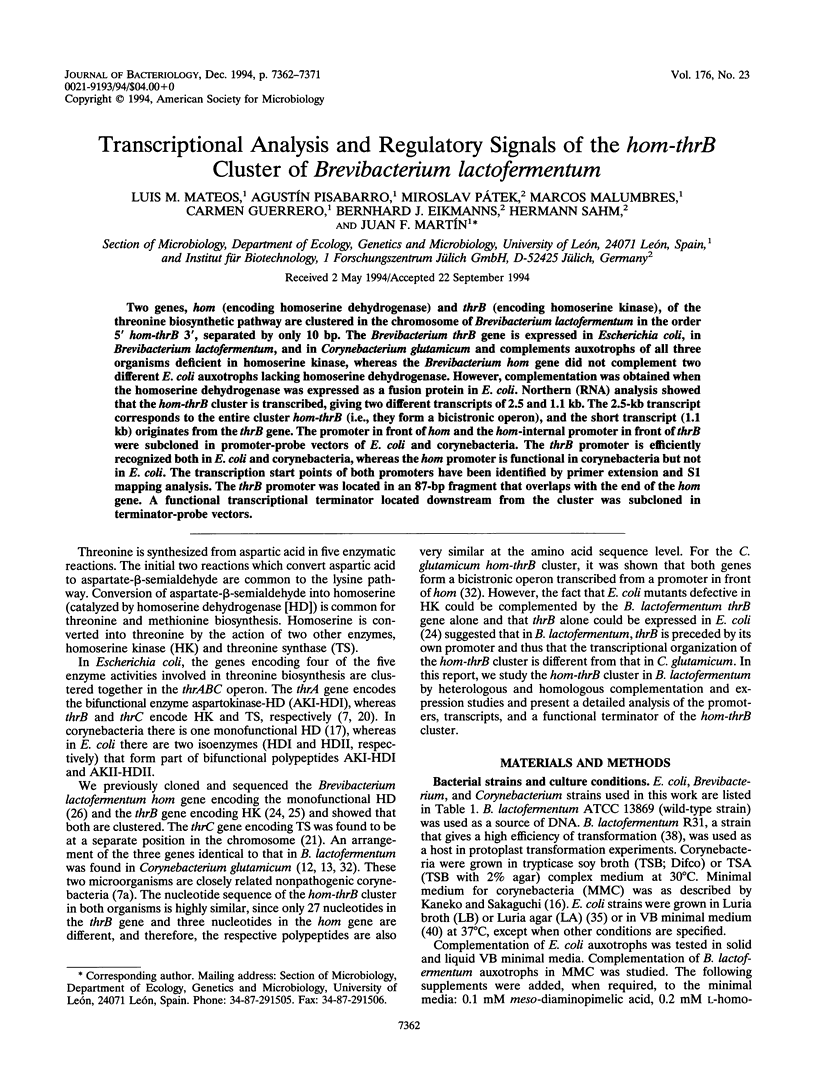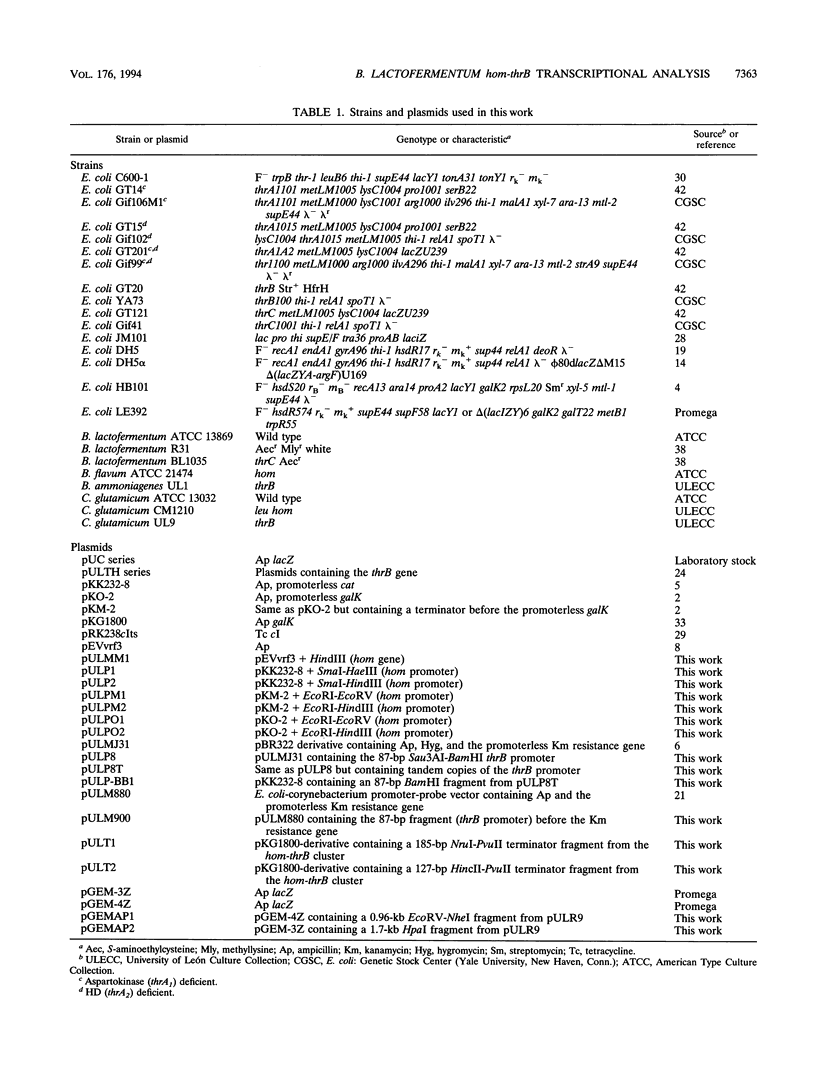Abstract
Two genes, hom (encoding homoserine dehydrogenase) and thrB (encoding homoserine kinase), of the threonine biosynthetic pathway are clustered in the chromosome of Brevibacterium lactofermentum in the order 5' hom-thrB 3', separated by only 10 bp. The Brevibacterium thrB gene is expressed in Escherichia coli, in Brevibacterium lactofermentum, and in Corynebacterium glutamicum and complements auxotrophs of all three organisms deficient in homoserine kinase, whereas the Brevibacterium hom gene did not complement two different E. coli auxotrophs lacking homoserine dehydrogenase. However, complementation was obtained when the homoserine dehydrogenase was expressed as a fusion protein in E. coli. Northern (RNA) analysis showed that the hom-thrB cluster is transcribed, giving two different transcripts of 2.5 and 1.1 kb. The 2.5-kb transcript corresponds to the entire cluster hom-thrB (i.e., they form a bicistronic operon), and the short transcript (1.1 kb) originates from the thrB gene. The promoter in front of hom and the hom-internal promoter in front of thrB were subcloned in promoter-probe vectors of E. coli and corynebacteria. The thrB promoter is efficiently recognized both in E. coli and corynebacteria, whereas the hom promoter is functional in corynebacteria but not in E. coli. The transcription start points of both promoters have been identified by primer extension and S1 mapping analysis. The thrB promoter was located in an 87-bp fragment that overlaps with the end of the hom gene. A functional transcriptional terminator located downstream from the cluster was subcloned in terminator-probe vectors.
Full text
PDF









Images in this article
Selected References
These references are in PubMed. This may not be the complete list of references from this article.
- Beskrovnaia O. Iu, Bukanov N. O., Okorokov A. L., Fonshtein M. Iu, Iankovskii N. K. Klonirovanie i izuchenie genov Corynebacterium glutamicum, komplementiruiushchikh mutatsii ilvA i thrA2 Escherichia coli. Genetika. 1989 Jan;25(1):49–56. [PubMed] [Google Scholar]
- Boyer H. W., Roulland-Dussoix D. A complementation analysis of the restriction and modification of DNA in Escherichia coli. J Mol Biol. 1969 May 14;41(3):459–472. doi: 10.1016/0022-2836(69)90288-5. [DOI] [PubMed] [Google Scholar]
- Brosius J. Plasmid vectors for the selection of promoters. Gene. 1984 Feb;27(2):151–160. doi: 10.1016/0378-1119(84)90136-7. [DOI] [PubMed] [Google Scholar]
- Börmann E. R., Eikmanns B. J., Sahm H. Molecular analysis of the Corynebacterium glutamicum gdh gene encoding glutamate dehydrogenase. Mol Microbiol. 1992 Feb;6(3):317–326. doi: 10.1111/j.1365-2958.1992.tb01474.x. [DOI] [PubMed] [Google Scholar]
- Cadenas R. F., Martín J. F., Gil J. A. Construction and characterization of promoter-probe vectors for Corynebacteria using the kanamycin-resistance reporter gene. Gene. 1991 Feb 1;98(1):117–121. doi: 10.1016/0378-1119(91)90113-p. [DOI] [PubMed] [Google Scholar]
- Crowl R., Seamans C., Lomedico P., McAndrew S. Versatile expression vectors for high-level synthesis of cloned gene products in Escherichia coli. Gene. 1985;38(1-3):31–38. doi: 10.1016/0378-1119(85)90200-8. [DOI] [PubMed] [Google Scholar]
- Favaloro J., Treisman R., Kamen R. Transcription maps of polyoma virus-specific RNA: analysis by two-dimensional nuclease S1 gel mapping. Methods Enzymol. 1980;65(1):718–749. doi: 10.1016/s0076-6879(80)65070-8. [DOI] [PubMed] [Google Scholar]
- Follettie M. T., Peoples O. P., Agoropoulou C., Sinskey A. J. Gene structure and expression of the Corynebacterium flavum N13 ask-asd operon. J Bacteriol. 1993 Jul;175(13):4096–4103. doi: 10.1128/jb.175.13.4096-4103.1993. [DOI] [PMC free article] [PubMed] [Google Scholar]
- Follettie M. T., Shin H. K., Sinskey A. J. Organization and regulation of the Corynebacterium glutamicum hom-thrB and thrC loci. Mol Microbiol. 1988 Jan;2(1):53–62. doi: 10.1111/j.1365-2958.1988.tb00006.x. [DOI] [PubMed] [Google Scholar]
- Han K. S., Archer J. A., Sinskey A. J. The molecular structure of the Corynebacterium glutamicum threonine synthase gene. Mol Microbiol. 1990 Oct;4(10):1693–1702. doi: 10.1111/j.1365-2958.1990.tb00546.x. [DOI] [PubMed] [Google Scholar]
- Hanahan D. Studies on transformation of Escherichia coli with plasmids. J Mol Biol. 1983 Jun 5;166(4):557–580. doi: 10.1016/s0022-2836(83)80284-8. [DOI] [PubMed] [Google Scholar]
- Jackson E. N., Yanofsky C. Internal promoter of the tryptophan operon of Escherichia coli is located in a structural gene. J Mol Biol. 1972 Aug 21;69(2):307–313. doi: 10.1016/0022-2836(72)90232-x. [DOI] [PubMed] [Google Scholar]
- Kieser T. Factors affecting the isolation of CCC DNA from Streptomyces lividans and Escherichia coli. Plasmid. 1984 Jul;12(1):19–36. doi: 10.1016/0147-619x(84)90063-5. [DOI] [PubMed] [Google Scholar]
- Low B. Formation of merodiploids in matings with a class of Rec- recipient strains of Escherichia coli K12. Proc Natl Acad Sci U S A. 1968 May;60(1):160–167. doi: 10.1073/pnas.60.1.160. [DOI] [PMC free article] [PubMed] [Google Scholar]
- Malumbres M., Mateos L. M., Lumbreras M. A., Guerrero C., Martín J. F. Analysis and expression of the thrC gene of Brevibacterium lactofermentum and characterization of the encoded threonine synthase. Appl Environ Microbiol. 1994 Jul;60(7):2209–2219. doi: 10.1128/aem.60.7.2209-2219.1994. [DOI] [PMC free article] [PubMed] [Google Scholar]
- Mateos L. M., del Real G., Aguilar A., Martín J. F. Cloning and expression in Escherichia coli of the homoserine kinase (thrB) gene from Brevibacterium lactofermentum. Mol Gen Genet. 1987 Mar;206(3):361–367. doi: 10.1007/BF00428872. [DOI] [PubMed] [Google Scholar]
- Mateos L. M., del Real G., Aguilar A., Martín J. F. Nucleotide sequence of the homoserine dehydrogenase (thr A) gene of Brevibacterium lactofermentum. Nucleic Acids Res. 1987 Dec 23;15(24):10598–10598. doi: 10.1093/nar/15.24.10598. [DOI] [PMC free article] [PubMed] [Google Scholar]
- Mateos L. M., del Real G., Aguilar A., Martín J. F. Nucleotide sequence of the homoserine kinase (thr B) gene of Brevibacterium lactofermentum. Nucleic Acids Res. 1987 May 11;15(9):3922–3922. doi: 10.1093/nar/15.9.3922. [DOI] [PMC free article] [PubMed] [Google Scholar]
- Messing J., Crea R., Seeburg P. H. A system for shotgun DNA sequencing. Nucleic Acids Res. 1981 Jan 24;9(2):309–321. doi: 10.1093/nar/9.2.309. [DOI] [PMC free article] [PubMed] [Google Scholar]
- Messing J. New M13 vectors for cloning. Methods Enzymol. 1983;101:20–78. doi: 10.1016/0076-6879(83)01005-8. [DOI] [PubMed] [Google Scholar]
- Mitra G., Martin-Zanca D., Barbacid M. Identification and biochemical characterization of p70TRK, product of the human TRK oncogene. Proc Natl Acad Sci U S A. 1987 Oct;84(19):6707–6711. doi: 10.1073/pnas.84.19.6707. [DOI] [PMC free article] [PubMed] [Google Scholar]
- Nagahari K., Tanaka T., Hishinuma F., Kuroda M., Sakaguchi K. Control of tryptophan synthetase amplified by varying the numbers of composite plasmids in Escherichia coli cells. Gene. 1977 Mar;1(2):141–152. doi: 10.1016/0378-1119(77)90025-7. [DOI] [PubMed] [Google Scholar]
- Peoples O. P., Liebl W., Bodis M., Maeng P. J., Follettie M. T., Archer J. A., Sinskey A. J. Nucleotide sequence and fine structural analysis of the Corynebacterium glutamicum hom-thrB operon. Mol Microbiol. 1988 Jan;2(1):63–72. doi: 10.1111/j.1365-2958.1988.tb00007.x. [DOI] [PubMed] [Google Scholar]
- Rosenberg M., Chepelinsky A. B., McKenney K. Studying promoters and terminators by gene fusion. Science. 1983 Nov 18;222(4625):734–739. doi: 10.1126/science.6356355. [DOI] [PubMed] [Google Scholar]
- Saint Girons I., Margarita D. Evidence for an internal promoter in the Escherichia coli threonine operon. J Bacteriol. 1985 Jan;161(1):461–462. doi: 10.1128/jb.161.1.461-462.1985. [DOI] [PMC free article] [PubMed] [Google Scholar]
- Sanger F., Nicklen S., Coulson A. R. DNA sequencing with chain-terminating inhibitors. Proc Natl Acad Sci U S A. 1977 Dec;74(12):5463–5467. doi: 10.1073/pnas.74.12.5463. [DOI] [PMC free article] [PubMed] [Google Scholar]
- Sano K., Matsui K. Structure and function of the trp operon control regions of Brevibacterium lactofermentum, a glutamic-acid-producing bacterium. Gene. 1987;53(2-3):191–200. doi: 10.1016/0378-1119(87)90007-2. [DOI] [PubMed] [Google Scholar]
- Santamaria R. I., Gil J. A., Martin J. F. High-frequency transformation of Brevibacterium lactofermentum protoplasts by plasmid DNA. J Bacteriol. 1985 Apr;162(1):463–467. doi: 10.1128/jb.162.1.463-467.1985. [DOI] [PMC free article] [PubMed] [Google Scholar]
- Santamaría R. I., Martín J. F., Gil J. A. Identification of a promoter sequence in the plasmid pUL340 of Brevibacterium lactofermentum and construction of new cloning vectors for corynebacteria containing two selectable markers. Gene. 1987;56(2-3):199–208. doi: 10.1016/0378-1119(87)90137-5. [DOI] [PubMed] [Google Scholar]
- Strohl W. R. Compilation and analysis of DNA sequences associated with apparent streptomycete promoters. Nucleic Acids Res. 1992 Mar 11;20(5):961–974. doi: 10.1093/nar/20.5.961. [DOI] [PMC free article] [PubMed] [Google Scholar]
- Thèze J., Saint-Girons I. Threonine locus of Escherichia coli K-12: genetic structure and evidence for an operon. J Bacteriol. 1974 Jun;118(3):990–998. doi: 10.1128/jb.118.3.990-998.1974. [DOI] [PMC free article] [PubMed] [Google Scholar]
- Tinoco I., Jr, Borer P. N., Dengler B., Levin M. D., Uhlenbeck O. C., Crothers D. M., Bralla J. Improved estimation of secondary structure in ribonucleic acids. Nat New Biol. 1973 Nov 14;246(150):40–41. doi: 10.1038/newbio246040a0. [DOI] [PubMed] [Google Scholar]
- Yanisch-Perron C., Vieira J., Messing J. Improved M13 phage cloning vectors and host strains: nucleotide sequences of the M13mp18 and pUC19 vectors. Gene. 1985;33(1):103–119. doi: 10.1016/0378-1119(85)90120-9. [DOI] [PubMed] [Google Scholar]
- Zakin M. M., Duchange N., Ferrara P., Cohen G. N. Nucleotide sequence of the metL gene of Escherichia coli. Its product, the bifunctional aspartokinase ii-homoserine dehydrogenase II, and the bifunctional product of the thrA gene, aspartokinase I-homoserine dehydrogenase I, derive from a common ancestor. J Biol Chem. 1983 Mar 10;258(5):3028–3031. [PubMed] [Google Scholar]
- de Boer H. A. A versatile plasmid system for the study of prokaryotic transcription signals in Escherichia coli. Gene. 1984 Oct;30(1-3):251–255. doi: 10.1016/0378-1119(84)90129-x. [DOI] [PubMed] [Google Scholar]






